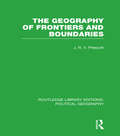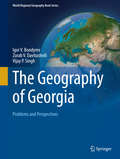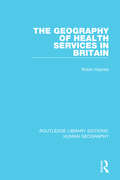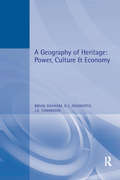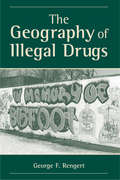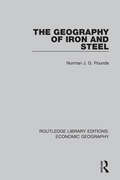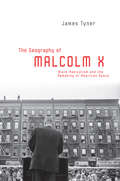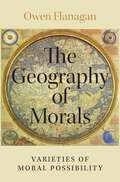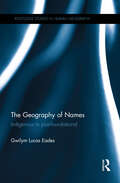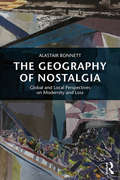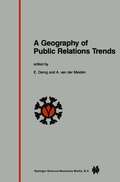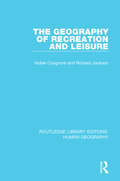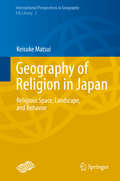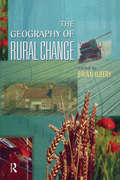- Table View
- List View
The Geography of Frontiers and Boundaries (Routledge Library Editions: Political Geography)
by J. R. PrescottThis book, originally published in 1986, shows the importance of geography in international power politics and shows how geopolitical thought influences policy-making and action. It considers the various elements within international power politics such as ideologies, territorial competition and spheres of influences, and shows how geographical considerations are crucial to each element. It considers the effects of distance on global power politics and explores how the geography of international communication and contact and the geography of economic and social patterns change over time and affect international power balances.
The Geography of Frontiers and Boundaries (Routledge Library Editions: Political Geography)
by J. R. PrescottThis book, originally published in 1986, shows the importance of geography in international power politics and shows how geopolitical thought influences policy-making and action. It considers the various elements within international power politics such as ideologies, territorial competition and spheres of influences, and shows how geographical considerations are crucial to each element. It considers the effects of distance on global power politics and explores how the geography of international communication and contact and the geography of economic and social patterns change over time and affect international power balances.
The Geography of Georgia: Problems and Perspectives (World Regional Geography Book Series)
by Igor V. Bondyrev Zurab V. Davitashvili Vijay P. SinghThis book discusses the political and economic history and geography of Georgia, the problems it has faced, and how it has overcome and is still overcoming them. In most countries, at the end of the 20th century the successful resolution of social-economic, political, demographic and ecological problems was largely dependent on effectively protecting the population and economic assets from natural disasters and on ensuring conditions for their sustainable development. These problems are most acute in mountainous regions like Georgia, where the unplanned development of natural ecosystems has had drastic consequences. It is therefore necessary to understand not only the probability of changing conditions (natural as well as political and demographic), but also the probability of the resulting economic losses. The book is divided into four sections; historical and political geography, geological processes, ecological processes and developmental geography. In the historical and political geography section the authors present a detailed discussion on ancient history, historical and political geography, ethnic groups and religions, demographics and socio-cultural geography. The geological processes section contains information on geology, geodynamical processes, glacial and periglacial processes. The ecological processes section examines a variety of landscapes and ecosystems, aspects of deforestation, reforestation and desertification along with anthropogenic impacts on the environment. The developmental geography section looks at different economies, natural resources, sustainable development and climate change.
The Geography of Health Services in Britain. (Routledge Library Editions: Human Geography)
by Robin HaynesThis book is about geographical variation in the organisation, provision and use of health services in Britain. Its main theme is that neither the quantity nor the quality of health care provided by the National Health Service (NHS) is uniform from place to place. Chapters discuss and evaluate: The reorganisation of the NHS in the years up to 1987 The relationships between the need for health care and the supply of health services The redistribution of health service resources geographically The distribution of doctors, dentists, community nurses and hospitals across the UK Access to health services The distribution of both private health facilities and social welfare services and their effect on the NHS.
The Geography of Health Services in Britain. (Routledge Library Editions: Human Geography #9)
by Robin HaynesThis book is about geographical variation in the organisation, provision and use of health services in Britain. Its main theme is that neither the quantity nor the quality of health care provided by the National Health Service (NHS) is uniform from place to place. Chapters discuss and evaluate: The reorganisation of the NHS in the years up to 1987 The relationships between the need for health care and the supply of health services The redistribution of health service resources geographically The distribution of doctors, dentists, community nurses and hospitals across the UK Access to health services The distribution of both private health facilities and social welfare services and their effect on the NHS.
A Geography of Heritage
by Brian Graham Greg Ashworth John TunbridgeThe concept of heritage relates to the ways in which contemporary society uses the past as a social, political or economic resource. However, heritage is open to interpretation and its value may be perceived from differing perspectives - often reflecting divisions in society. Moreover, the schism between the cultural and economic uses of heritage also gives rise to potential conflicts of interest. Examining these issues in depth, this book is the first sustained attempt to integrate the study of heritage into contemporary human geography. It is structured around three themes: the diversity of use and consumption of heritage as a multi-sold cultural and economic resource; the conflicts and tensions arising from this multiplicity of uses, producers and consumers; and the relationship between heritage and identity at a variety of scales.
A Geography of Heritage: Power, Culture And Economy (A\hodder Arnold Publication)
by Brian Graham Greg Ashworth John TunbridgeThe concept of heritage relates to the ways in which contemporary society uses the past as a social, political or economic resource. However, heritage is open to interpretation and its value may be perceived from differing perspectives - often reflecting divisions in society. Moreover, the schism between the cultural and economic uses of heritage also gives rise to potential conflicts of interest. Examining these issues in depth, this book is the first sustained attempt to integrate the study of heritage into contemporary human geography. It is structured around three themes: the diversity of use and consumption of heritage as a multi-sold cultural and economic resource; the conflicts and tensions arising from this multiplicity of uses, producers and consumers; and the relationship between heritage and identity at a variety of scales.
The Geography Of Illegal Drugs
by George F RengertThe nightly news and other media provide a constant reminder of illegal drug transport over American borders and along routes between various U.S. cities. The general public is well aware that law enforcement efforts to address the foreign supply and trafficking of illegal drugs into the United States is an ongoing battle.This useful and readable compendium gives a fascinating account of how illegal drugs are transported into and around the United States and throughout its neighborhoods. Criminologist and geographer George F. Rengert takes a unique approach to the problem of illegal drug distribution and U.S. drug markets. Using maps and charts to illustrate his findings, Rengert applies spacial diffusion models to the illegal drug trade and explains why certain drugs are transported and found in different parts of the country. For example, the highest concentration of marijuana plants is not on either coast, but rather across the middle of the United States?throughout what is known as the corn belt. At the local level Rengert assesses the patterns and processes that interconnect drug sales and neighborhood deterioration and change.The book also addresses the important issues of how illegal drugs in this country operate on wholesale and retail levels and ways in which law enforcement at the federal, state, and local levels contend with this widespread problem. Using ethnographic material to provide real-life examples, Rengert explores how drug dealers on the street expand spatially and predictably in their neighborhoods. He illustrates how this knowledge helps law enforcement in efforts to get these drugs off the streets.
The Geography Of Illegal Drugs
by George F RengertThe nightly news and other media provide a constant reminder of illegal drug transport over American borders and along routes between various U.S. cities. The general public is well aware that law enforcement efforts to address the foreign supply and trafficking of illegal drugs into the United States is an ongoing battle.This useful and readable compendium gives a fascinating account of how illegal drugs are transported into and around the United States and throughout its neighborhoods. Criminologist and geographer George F. Rengert takes a unique approach to the problem of illegal drug distribution and U.S. drug markets. Using maps and charts to illustrate his findings, Rengert applies spacial diffusion models to the illegal drug trade and explains why certain drugs are transported and found in different parts of the country. For example, the highest concentration of marijuana plants is not on either coast, but rather across the middle of the United States?throughout what is known as the corn belt. At the local level Rengert assesses the patterns and processes that interconnect drug sales and neighborhood deterioration and change.The book also addresses the important issues of how illegal drugs in this country operate on wholesale and retail levels and ways in which law enforcement at the federal, state, and local levels contend with this widespread problem. Using ethnographic material to provide real-life examples, Rengert explores how drug dealers on the street expand spatially and predictably in their neighborhoods. He illustrates how this knowledge helps law enforcement in efforts to get these drugs off the streets.
The Geography of Iron and Steel (Routledge Library Editions: Economic Geography)
by Allan M. WilliamsThis volume provides a survey of the world’s iron-ore resources during the 1960s and the distribution of the iron and steel industries. There are specific chapters on the UK , Western Europe, the USSR, the USA and smaller sections on Africa, Latin America and South East Asia. Particular attention is paid to the political aspects of the steel industry, for example in Post-War Germany.
The Geography of Iron and Steel (Routledge Library Editions: Economic Geography)
by Allan M. WilliamsThis volume provides a survey of the world’s iron-ore resources during the 1960s and the distribution of the iron and steel industries. There are specific chapters on the UK , Western Europe, the USSR, the USA and smaller sections on Africa, Latin America and South East Asia. Particular attention is paid to the political aspects of the steel industry, for example in Post-War Germany.
The Geography of Malcolm X: Black Radicalism and the Remaking of American Space
by James TynerFirst published in 2006. Routledge is an imprint of Taylor & Francis, an informa company.
The Geography of Malcolm X: Black Radicalism and the Remaking of American Space
by James TynerFirst published in 2006. Routledge is an imprint of Taylor & Francis, an informa company.
The Geography of Morals: Varieties of Moral Possibility
by Owen FlanaganThe Geography of Morals is a work of extraordinary ambition: an indictment of the parochialism of Western philosophy, a comprehensive dialogue between anthropology, empirical moral psychology, behavioral economics, and cross-cultural philosophy, and a deep exploration of the opportunities for self, social, and political improvement provided by world philosophy. We live in multicultural, cosmopolitan worlds. These worlds are distinctive moral ecologies in which people enact and embody different lived philosophies and conceive of mind, morals, and the meaning of life differently from the typical WEIRD -- Western, Educated, Industrialized, Rich, Democratic -- person. This is not a predicament; it is an opportunity. Many think that cross cultural understanding is useful for developing a modus vivendi where people from different worlds are not at each other's throats and tolerate each other. Flanagan presses the much more exciting possibility that cross-cultural philosophy provides opportunities for exploring the varieties of moral possibility, learning from other traditions, and for self, social, and political improvement. There are ways of worldmaking in other living traditions -- Confucian, Daoist, Buddhist, Hindu, Jain, Muslim, Amerindian, and African -- that citizens in Western countries can benefit from. Cross-cultural learning is protection against what Alasdair MacIntyre refers to as being "imprisoned by one's upbringing." Flanagan takes up perennial topics of whether there is anything to the idea of a common human nature, psychobiological sources of human morality, the nature of the self, the role of moral excellence in a good human life, and whether and how empirical inquiry into morality can contribute to normative ethics. The Geography of Morals exemplifies how one can respectfully conceive of multiculturalism and global interaction as providing not only opportunities for business and commerce, but also opportunities for socio-moral and political improvement on all sides. This is a book that aims to change how normative ethics and moral psychology are done.
The Geography of Morals: Varieties of Moral Possibility
by Owen FlanaganThe Geography of Morals is a work of extraordinary ambition: an indictment of the parochialism of Western philosophy, a comprehensive dialogue between anthropology, empirical moral psychology, behavioral economics, and cross-cultural philosophy, and a deep exploration of the opportunities for self, social, and political improvement provided by world philosophy. We live in multicultural, cosmopolitan worlds. These worlds are distinctive moral ecologies in which people enact and embody different lived philosophies and conceive of mind, morals, and the meaning of life differently from the typical WEIRD -- Western, Educated, Industrialized, Rich, Democratic -- person. This is not a predicament; it is an opportunity. Many think that cross cultural understanding is useful for developing a modus vivendi where people from different worlds are not at each other's throats and tolerate each other. Flanagan presses the much more exciting possibility that cross-cultural philosophy provides opportunities for exploring the varieties of moral possibility, learning from other traditions, and for self, social, and political improvement. There are ways of worldmaking in other living traditions -- Confucian, Daoist, Buddhist, Hindu, Jain, Muslim, Amerindian, and African -- that citizens in Western countries can benefit from. Cross-cultural learning is protection against what Alasdair MacIntyre refers to as being "imprisoned by one's upbringing." Flanagan takes up perennial topics of whether there is anything to the idea of a common human nature, psychobiological sources of human morality, the nature of the self, the role of moral excellence in a good human life, and whether and how empirical inquiry into morality can contribute to normative ethics. The Geography of Morals exemplifies how one can respectfully conceive of multiculturalism and global interaction as providing not only opportunities for business and commerce, but also opportunities for socio-moral and political improvement on all sides. This is a book that aims to change how normative ethics and moral psychology are done.
The Geography of Names: Indigenous to post-foundational (Routledge Studies in Human Geography)
by Gwilym Lucas EadesThis book examines geographical names, place-names, and toponymy from philosophical and cultural evolutionary perspectives. Geographical name-tracking-networks (Geo-NTNs) are posited as tools for tracking names through time and across space, and for making sense of how names evolve both temporally and spatially. Examples from North and South American indigenous groups, the Canadian arctic, Wales, England, and the Middle East are brought into a theoretical framework for making sense of aspects of place-naming practices, beliefs, and systems. New geographical tools such as geographic information systems (GIS) and global positioning systems (GPS) are demonstrated to be important in the production and maintenance of robust networks for keeping names and their associated meanings viable in a rapidly changing world where place-naming is being taken up increasingly in social media and other new mapping platforms. The Geography of Names makes the case that geographical names are transmitted memetically (i.e. as cultural units, or memes) through what Saul Kripke called communication chains. Combining insights from Kripke with views of later Wittgenstein on language and names as being inherently spatial, the present work advances theories of both these thinkers into an explicitly geographical inquiry that advances philosophical and practical aspects of naming, language, and mapping.
The Geography of Names: Indigenous to post-foundational (Routledge Studies in Human Geography)
by Gwilym Lucas EadesThis book examines geographical names, place-names, and toponymy from philosophical and cultural evolutionary perspectives. Geographical name-tracking-networks (Geo-NTNs) are posited as tools for tracking names through time and across space, and for making sense of how names evolve both temporally and spatially. Examples from North and South American indigenous groups, the Canadian arctic, Wales, England, and the Middle East are brought into a theoretical framework for making sense of aspects of place-naming practices, beliefs, and systems. New geographical tools such as geographic information systems (GIS) and global positioning systems (GPS) are demonstrated to be important in the production and maintenance of robust networks for keeping names and their associated meanings viable in a rapidly changing world where place-naming is being taken up increasingly in social media and other new mapping platforms. The Geography of Names makes the case that geographical names are transmitted memetically (i.e. as cultural units, or memes) through what Saul Kripke called communication chains. Combining insights from Kripke with views of later Wittgenstein on language and names as being inherently spatial, the present work advances theories of both these thinkers into an explicitly geographical inquiry that advances philosophical and practical aspects of naming, language, and mapping.
The Geography of Nostalgia: Global and Local Perspectives on Modernity and Loss (Routledge Advances in Sociology)
by Alastair BonnettWe are familiar with the importance of 'progress' and 'change'. But what about loss? Across the world, from Beijing to Birmingham, people are talking about loss: about the loss that occurs when populations try to make new lives in new lands as well as the loss of traditions, languages and landscapes. The Geography of Nostalgia is the first study of loss as a global and local phenomenon, something that occurs on many different scales and which connects many different people. The Geography of Nostalgia explores nostalgia as a child of modernity but also as a force that exceeds and challenges modernity. The book begins at a global level, addressing the place of nostalgia within both global capitalism and anti-capitalism. In Chapter Two it turns to the contested role of nostalgia in debates about environmentalism and social constructionism. Chapter Three addresses ideas of Asia and India as nostalgic forms. The book then turns to more particular and local landscapes: the last three chapters explore the yearnings of migrants for distant homelands, and the old cities and ancient forests that are threatened by modernity but which modern people see as sites of authenticity and escape. The Geography of Nostalgia is a reader friendly text that will appeal to a variety of markets. In the university sector it is a student friendly, interdisciplinary text that will be welcomed across a broad range of courses, including cultural geography, post-colonial studies, landscape and planning, sociology and history.
The Geography of Nostalgia: Global and Local Perspectives on Modernity and Loss (Routledge Advances in Sociology)
by Alastair BonnettWe are familiar with the importance of 'progress' and 'change'. But what about loss? Across the world, from Beijing to Birmingham, people are talking about loss: about the loss that occurs when populations try to make new lives in new lands as well as the loss of traditions, languages and landscapes. The Geography of Nostalgia is the first study of loss as a global and local phenomenon, something that occurs on many different scales and which connects many different people. The Geography of Nostalgia explores nostalgia as a child of modernity but also as a force that exceeds and challenges modernity. The book begins at a global level, addressing the place of nostalgia within both global capitalism and anti-capitalism. In Chapter Two it turns to the contested role of nostalgia in debates about environmentalism and social constructionism. Chapter Three addresses ideas of Asia and India as nostalgic forms. The book then turns to more particular and local landscapes: the last three chapters explore the yearnings of migrants for distant homelands, and the old cities and ancient forests that are threatened by modernity but which modern people see as sites of authenticity and escape. The Geography of Nostalgia is a reader friendly text that will appeal to a variety of markets. In the university sector it is a student friendly, interdisciplinary text that will be welcomed across a broad range of courses, including cultural geography, post-colonial studies, landscape and planning, sociology and history.
A Geography of Public Relations Trends: Selected Proceedings of the 10th Public Relations World Congress “Between People and Power”, Amsterdam 3 – 7 June 1985
by E. Denig A. Van Der MeidenSelected Proceedings of the Xth Public Relations World Congress `Between People and Power', Amsterdam, June 3-7, 1985.
The Geography of Recreation and Leisure (Routledge Library Editions: Human Geography)
by Isobel Cosgrove Richard JacksonOriginally published in 1972, this book discusses changing attitudes to work and leisure and patterns of leisure activity, asking if recreation, as an economic activity, a distinctive spatial expression. It examines characteristics of spa towns and coastal resorts in the nineteenth century as well as provision of leisure amenities in urban and rural areas of contemporary Britain and the changing levels of demand for and supply of recreation in North America.
The Geography of Recreation and Leisure (Routledge Library Editions: Human Geography #4)
by Isobel Cosgrove Richard JacksonOriginally published in 1972, this book discusses changing attitudes to work and leisure and patterns of leisure activity, asking if recreation, as an economic activity, a distinctive spatial expression. It examines characteristics of spa towns and coastal resorts in the nineteenth century as well as provision of leisure amenities in urban and rural areas of contemporary Britain and the changing levels of demand for and supply of recreation in North America.
Geography of Religion in Japan: Religious Space, Landscape, and Behavior (International Perspectives in Geography #2)
by Keisuke MatsuiThis book discusses modern aspects of Japanese religion in terms of cultural geography. To understand the function of religion, it is essential to examine it in the context of local societies. One of the distinguishing characteristics of Japanese religion is its diversity; indeed, it is often remarked that “Japan is a museum of religions.” In this work, the author clarifies some geographical aspects of the complex situation of Japanese religion. Chapter 1 discusses the trend of geographical studies of religion in Japan, of which four types can be identified. Chapter 2 focuses on certain characteristics of Japanese religious traditions by discussing tree worship and the landscape of sacred places. Chapter 3 clarifies regional divisions in the catchment areas of Japanese Shintoism by analyzing the distribution of certain types of believers. The author discusses two case studies: the Kasama Inari Shrine and the Kanamura Shrine. Chapter 4 discusses some modern aspects of sacred places and tourism through two case studies. The first part of the chapter focuses on changes in the types of businesses at the Omotesando of the Naritasan Shinshoji-Monzenmachi, and the following sections examine the revitalization of the local community through the promotion of religious tourism.
The Geography of Rural Change
by Brian IlberyThe Geography of Rural Change provides a thorough examination of the processes and outcomes of rural change as a result of a period of major restructuring in developed market economies. After outlining the main dimensions of rural change, the book progresses from a discussion of theoretical insights into rural restructuring to a consideration of both the extensive use of rural land and the changing nature of rural economy and society. The text places an emphasis on relevant principles, concepts and theories of rural change, and these are supported by extensive case study evidence drawn from different parts of the developed world.The Geography of Rural Change is written for undergraduates taking courses in human geography, agricultural geography, rural geography, rural sociology, planning and agricultural economics.
The Geography of Rural Change
by Brian IlberyThe Geography of Rural Change provides a thorough examination of the processes and outcomes of rural change as a result of a period of major restructuring in developed market economies. After outlining the main dimensions of rural change, the book progresses from a discussion of theoretical insights into rural restructuring to a consideration of both the extensive use of rural land and the changing nature of rural economy and society. The text places an emphasis on relevant principles, concepts and theories of rural change, and these are supported by extensive case study evidence drawn from different parts of the developed world.The Geography of Rural Change is written for undergraduates taking courses in human geography, agricultural geography, rural geography, rural sociology, planning and agricultural economics.
